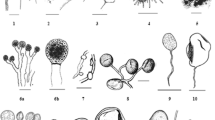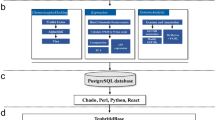Summary
During the embryonic development of their host the t-symbiotes of the leafhopperEuscelis plebejus appear in two different morphological types: “infective form” and “vegetative form”.
The t-symbiotes occur in the infective form only for a short period of time, that is in the transitory mycetome during the entry into the t-mycetocytes. The infective forms multiply by ingrowth of their membranes. During the rest of the embryonic development the t-symbiotes appear as vegetative form. The infective form of the t-symbiotes is distinguished from the highly lobed vegetative form by the more rounded contour of the cells and the lower electron density of the cytoplasm.
Each t-symbiote is surrounded by two membranes. As the ooplasm penetrates the symbiote mass, each symbiote is enclosed by an additional host membrane. In the mycetocytes this third membrance is replaced by a new one, which obviously originates from the cytoplasm of the host cell.
The t-symbiotes are characterised by “dense bodies” of variable size, which are digestible by pronase and chymotrypsin Furthermore in their cytoplasm two morphologically distinct types of paracrystalline inclusions are found. — It was impossible to demonstrate with certainty DNA-structures in any symbiote form.
Zusammenfassung
Ebenso wie die a-Symbionten (Körner, 1972) treten auch die t-Symbionten der KleinzikadeEuscelis plebejus während der Embryonalentwicklung des Wirts in zwei morphologischen Typen auf, die als “Infektionsstadium” und als “vegetative Form” beschrieben werden.
Die t-Symbionten zeigen nur im transitorischen Mycetom während der Besiedelung der t-Mycetocyten die Gestalt von Infektionsstadien. Diese Stadien teilen sich durch septenartiges Einwachsen der Symbiontenmembranen. Während der übrigen Zeit der Embryonalent wicklung erscheinen die t-Symbionten als vegetative Formen. Morphologisch lassen sich die t-Infektionssatadien durch geschlossenere Konturen und eine höhere Elektronendurchlässigkeit ihres Cytoplasmas von den hochgradig gelappten vegetativen Formen unterscheiden.
Die Membranverhältnisse sind ähnlich denen der a-Symbionten: zwei symbionteneigene Membranen und eine Hüllmembran des Wirts, die jeden einzelnen Symbionten vakuolenartig einschließt. Diese Hüllmembran entsteht zunächst gleichzeitig mit dem Eindringen von Ooplasma in die Symbiontenmasse, wird jedoch in den Mycetocyten anscheinend vom Wirtscytoplasma neu gebildet.
Die t-Symbionten sind in jedem Stadium gekennzeichnet durch elektronendichte Körper unterschiedlicher Größe, die mit Pronase und mit Chymotrypsin abgebaut werden können. Weiterhin findet man in ihrem Cytoplasma zwei morphologisch verschiedene Typen kristallartiger Einschlüsse. —DNS-Strukturen waren cytologisch nicht mit Sicherheit nachzuweisen.
Similar content being viewed by others
Abbreviations
- ai :
-
a-Infektionsstadien
- eK:
-
elektronendichter Körper
- M1 :
-
innere Symbiontenmembran
- M2 :
-
äußere Symbiontenmembran
- M3 :
-
Hüllmembran
- Mi :
-
Mitochondrien
- Nu:
-
Zellkern
- pS:
-
“pilzförmige Strukturen”
- Ri:
-
Ribosomen
- ti :
-
t-Infektionsstadien
- tv :
-
vegetative t-Symbionten
Literatur
Anderson, W. A., André, J.: The extraction of some cell components with pronase and pepsin from thin sections of tissue embedded in an epon-araldite mixture. J. Microscopie7, 343–354 (1968)
Buchner, P.: Studien an intrazellulären Symbionten. V. Die symbiontischen Einrichtungen der Zikaden. Z. Morph. Ökol. Tiere4, 88–245 (1925)
Buchner, P.: Endosymbiose der Tiere mit pflanzlichen Mikroorganismen. Basel u. Stuttgart: Birkhäuser 1953
Buchner, P.: Endosymbiosis of animals with plant microorganisms. New York: Wiley 1965
Chang, K. P., Musgrave, A. J.: Multiple symbiosis in a leafhopper,Helochara communis Fitch (Cicadellidae: Homoptera): envelopes, nucleoids and inclusions of the symbiotes. J. Cell Sci.11, 275–293 (1972)
Dienes, L., Bullivant, S.: Morphology and reproductive process of the L forms of bacteria. II. Comparative study of L forms andMycoplasma with the electron microscope. J. Bact.25, 672–687 (1968)
Hamon, C.: Etude au microscope éléctronique des symbiotes à transmission héréditaire chez quelques insectes Homoptères auchénorhynques femelles. Z. Zellfrosch.119, 244–256 (1971)
Kellenberger, E., Ryter, A., Séchaud, J.: Electron microscope study of DNA-containing plasms. J. biophys. biochem. Cytol.4, 671–678 (1958)
Körner, H. K.: Die embryonale Entwicklung der symbiontenführenden Organe vonEuscelis plebejus Fall. (Homoptera-Cicadina). Oecologia (Berl.)2, 319–346 (1969a)
Körner, H. K.: Entwicklung der Symbiontenorgane einer Kleinzikade (Euscelis plebejus Fall.) nach Ausschaltung der Symbionten. Experientia (Basel)25, 767–768 (1969b)
Körner, H. K.: Zur Ultrastruktur der intrazellulären Symbionten im Embryo der KleinzikadeEuscelis plebejus Fall. (Homoptera-Cicadina). Z. Zellforsch.100, 466–473 (1969c)
Körner, H. K.: Die Entwicklung der Mycetome und die Feinstruktur der Symbionten in Embryo der KleinzikadeEuscelis plebejus Fall. Dissertation: Freiburg 1971
Körner, H. K.: Elektronenmikroskopische Untersuchungen am embryonalen Mycetom der KleinzikadeEuscelis plebejus Fall. (Homoptera, Cicadina). I. Die Feinstruktur der a-Symbionten. Z. Parasitenk.40, 203–226 (1972)
Körner, H. K., Feldhege, A.: Einschlußkörper in symbiontischen Bakterien einer Kleinzikade (Euscelis plebejus Fall.) Cytobiologie1, 203–207 (1970)
Körner, H. K., Sander, K.: Symbionten in der Embryonalentwicklung einer Zikade. Umschau72/8, 254–255 (1972)
Lanham, U. N.: Observations on the supposed intracellular symbiotic microorganisms of aphids. Science115, 459–460 (1952a)
Lanham, U. N.: Mitochondria or micro-organisms? Science116, 332–333 (1952b)
Louis, C., Laporte, M.: Caractères ultrastructuraux et différenciation de formes migratrices des symbiotes chezEuscelis plebejus (Hom., Jassidae). Ann. Soc. Ent. Fr. (N.S.)5, 799–809 (1969)
Müller, H. J.: Zur Systematik und Phylogenie der Zikaden-Endosymbiosen. Biol. Zbl.68, 343–368 (1949)
Müller, H. J.: Über die intrazellulare Symbiose der PeloridiideHemiodoecus fidelis (Homoptera, Coleorrhyncha) und ihre Stellung unter den Homopterensymbiosen. Zool. Anz.146, 150 (1951)
Müller, H. J.: Neuere Vorstellungen über Verbreitung und Phylogenie der Endosymbiosen der Zikaden. Z. Morph. Ökol. Tiere51, 190–210 (1962)
Müller, J.: Untersuchungen über die intrazellulare Symbiose einiger Aetalionidae, Eurymelidae und Cicadellidae (Homoptera, Auchenorrhyncha). Zool. Jb. Abt. System., Ökol. u. Geogr.96, 558–608 (1969)
Reynolds, E. S.: The use of lead citrate at high pH as an electron-opaque stain in electron microscopy. J. Cell Biol.17, 208–212 (1963)
Sabatini, B., Bensch, K., Barrnett, R. J.: Cytochemistry and electron microscopy. The preservation of cellular ultrastructure and enzymatic activity by aldehyde fixation. J. Cell Biol.17, 19–58 (1963)
Sander, K.: Analyse des ooplasmatischen Reaktionssystems vonEuscelis plebejus Fall. (Cicadina) durch Isolieren und Kombinieren von Keimteilen. I. Mitt.: Die Differenzierungsleistungen vorderer und hinterer Eiteile. Wilhelm Roux' Arch. Entwickl.-Mech. Org.151, 430–497 (1959)
Schwemmler, W.: Intracellular symbionts: a new type of primitive prokaryotes. Cytobiologie3, 427–429 (1971)
Schwemmler, W., Duthoit, J.-L., Kuhl, G., Vago, C.: Sprengung der Endosymbiose vonEuscelis plebejus F. und Ernährung aposymbiontischer Tiere mit synthetischer Diät (Homoptera, Cicadidae). Z. Morph. Ökol. Tiere74, 297–322 (1973)
Smith, D. S.: The structure of intersegmental muscle fibers in an insect,Periplaneta americana L. J. Cell Biol.29, 449–459 (1966)
Author information
Authors and Affiliations
Additional information
Mit Unterstützung durch die Deutsche Forschungsgemeinschaft.
Herrn Prof. Dr. K. Sander danke ich für stete Förderung meiner Arbeit.
Rights and permissions
About this article
Cite this article
Körner, H.K. Elektronenmikroskopische Untersuchungen am embryonalen Mycetom der KleinzikadeEuscelis plebejus Fall. (Homoptera, Cicadina). Z. F. Parasitenkunde 44, 149–164 (1974). https://doi.org/10.1007/BF02433467
Received:
Issue Date:
DOI: https://doi.org/10.1007/BF02433467




